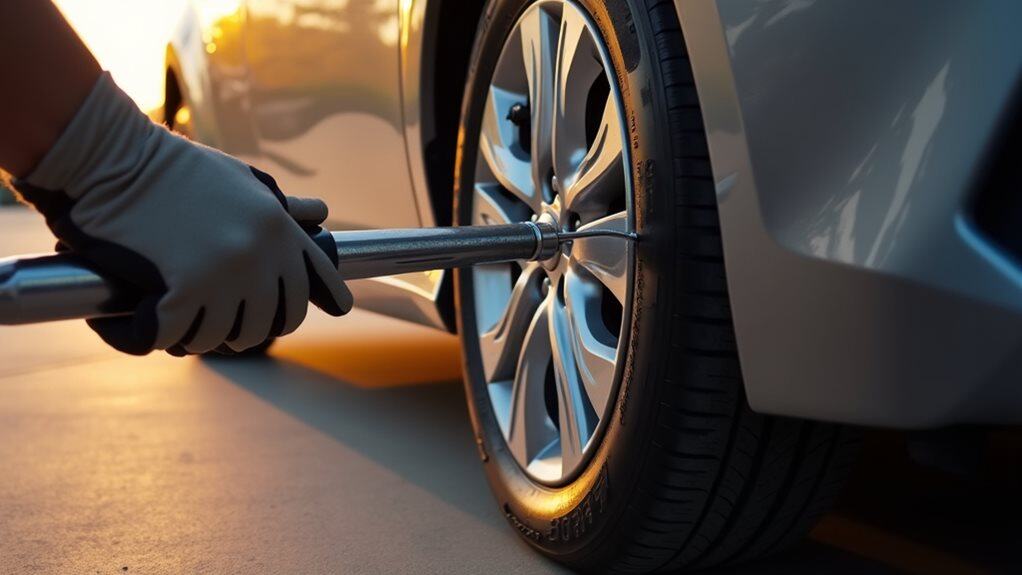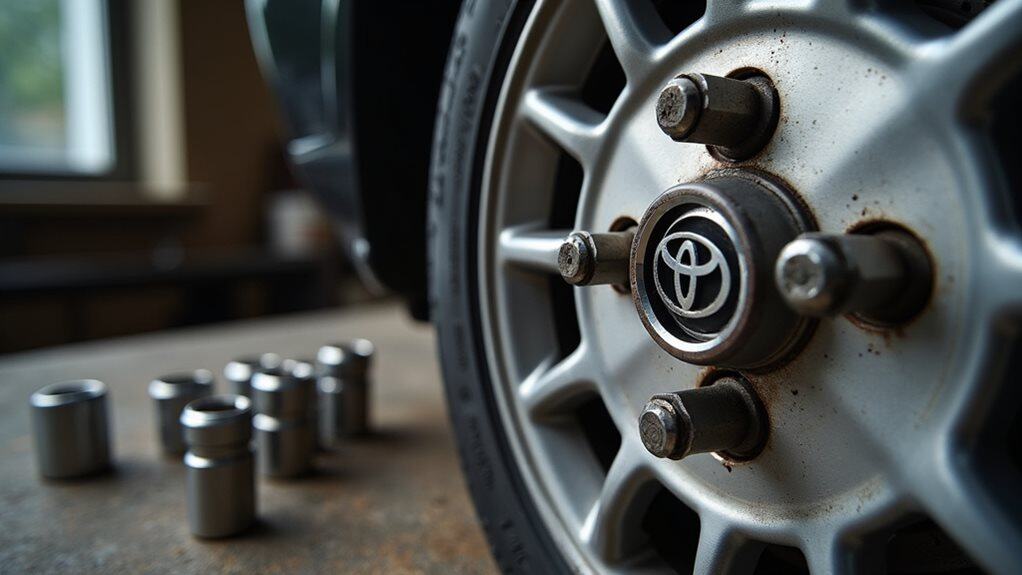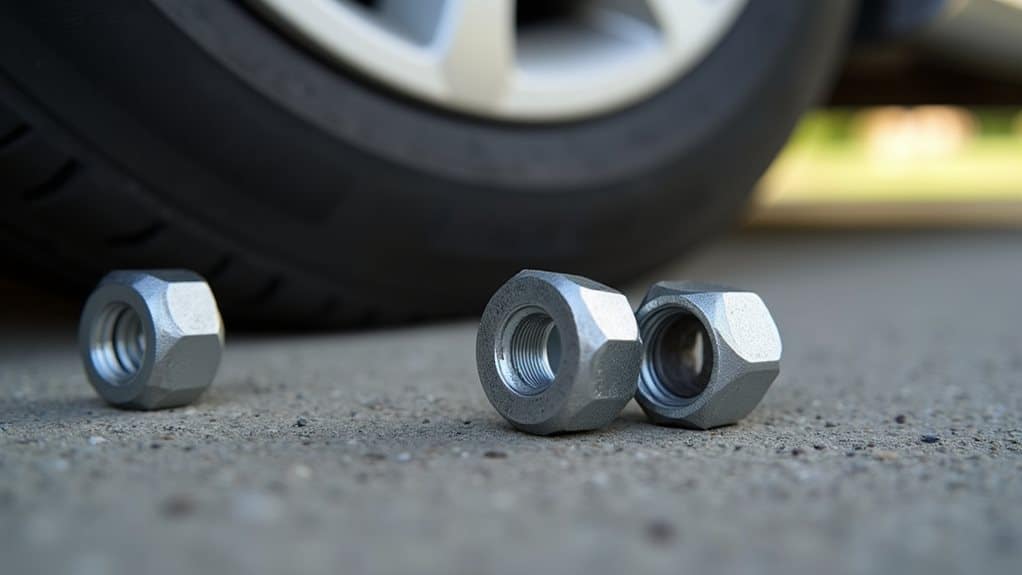You should torque Toyota Camry lug nuts to 76 ft·lb (103 Nm) using a calibrated 1/2″ torque wrench, hand‑start nuts in a star pattern, and do a first pass at ~30–40% of final torque before the final 76 ft·lb pass to make certain even clamping and avoid rotor warp or stud damage. Recheck torque after 50–100 miles, inspect threads and replace damaged hardware, and follow proper sockets and calibration procedures for consistent results — more practical tips follow.
Quick Tips
- Standard Toyota Camry lug nut torque: 76 ft·lb (103 Nm).
- Use a 1/2″ drive torque wrench and a 21 mm (13/16″) six‑point socket for tightening.
- Hand‑start lugs in a star pattern, first pass at ~30–40% then final to 76 ft·lb.
- Acceptable practical window: about 75–85 ft·lb; avoid below ~70 or above ~85 ft·lb.
- Recheck and record torque after 50–100 miles; replace damaged studs or nuts before reuse.
Recommended Lug Nut Torque for Toyota Camry Models

Although some sources list slightly different numbers, the widely accepted lug nut torque for most Toyota Camry models is 76 ft·lb (103 Nm), and you should use that value as your baseline when tightening wheels.
You’ll hand-tighten in a star pattern, then use a calibrated torque wrench to set 76 ft·lb, recheck after 50–100 miles, and note aluminum wheel sensitivity.
Always disconnect the negative battery terminal first when performing wheel or brake work to reduce electrical risks and ensure proper engine ground connection.
Why Correct Torque Matters for Safety and Component Life
You need to get lug nut torque right because under-torqued fasteners can work loose and cause wheel detachment, a sudden mechanical failure that risks loss of control.
Even, specified torque spreads clamping force across the wheel hub and rim, which prevents uneven stress that would warp brake rotors or cause uneven tire wear.
Over-torquing or inconsistent torque can stretch or break wheel studs and damage threads, so use a calibrated torque wrench and recheck torque after initial driving to protect studs, brakes, and overall component life.
Contact the site owner and provide the Cloudflare Ray ID and details of your actions to help resolve access issues.
Regular inspection of seals and checking for dark fluid spots can help you catch related issues early.
Prevents Wheel Detachment
Properly torquing the Camry’s lug nuts to the manufacturer’s specification of 76 ft‑lb (103 Nm) is what actually keeps the wheel clamped to the hub, and that clamping force matters under every driving condition.
If you under-torque, studs can loosen and the wheel may detach; if you over-torque, studs can stretch or break. Use a calibrated torque wrench and re-torque after initial driving.
Even Stress Distribution
When lug nuts are tightened to the correct specification, the clamping force spreads evenly across the wheel, hub, and studs, which reduces localized stress points that can cause warping or component failure.
You’ll guarantee consistent contact, minimize vibration and wobble, and prevent uneven tire or suspension wear.
Use a calibrated torque wrench and star pattern tightening, tightening in increments for uniform stress distribution.
Protects Brake and Studs
Although it might seem minor, tightening lug nuts to the specified 76 ft‑lbs on a Toyota Camry directly protects brake components and wheel studs from damage by keeping clamping forces within design limits; if you overtighten, the extra stress can warp or crack rotors, distort caliper alignment, and stretch or strip stud threads, while undertightening lets studs work loose and accelerates wear under variable loads.
Correct torque guarantees rotor alignment, even pad contact, prevents thread damage and stud stretch, reduces vibration, and prolongs component life; check torque after installation and periodically to catch damaged studs early and avoid costly brake or wheel failures.
Tools You Need to Torque Lug Nuts Properly
You’ll want the right torque wrench type for a Camry — a 1/2-inch drive click‑type or digital wrench covers the typical 70–100 ft‑lb range and gives repeatable readings.
Match that wrench with properly sized lug sockets to avoid rounding the nuts, and keep a breaker bar handy for initial loosening so you don’t stress the torque tool.
Finally, have your torque wrench calibrated regularly and store it properly, since accuracy drifts over time and a miscalibrated wrench can cause under‑ or over‑torqued lug nuts.
For heavy current applications like starters, ensure battery and ground cables use an appropriate low AWG gauge (e.g., 4 or 2 AWG) to minimize voltage drop and prevent overheating.
Essential Torque Wrench Types
Selecting the right torque wrench is critical if you want to tighten lug nuts correctly and avoid wheel damage or unsafe fastener preload, so it’s worth understanding the main types and drive sizes used in automotive work.
Use 1/2-inch drives for most lug nuts; 3/8-inch for lighter tasks, 3/4-inch or 1-inch only for heavy equipment. Click, digital, beam, dial, and split-beam options vary in accuracy, cost, and calibration needs.
Proper Socket Sizes
To get the job done right, start with the correct socket size and type for your Camry’s lug nuts: most Toyota Camry models use a 21 mm (13/16″) hex socket, which fits the six-sided lug nut profile snugly and reduces the chance of rounding the nut when you torque it.
Use 6-point, high-grade alloy sockets; verify aftermarket wheel sizes and prefer chrome-moly impact sockets with proper drive adapters.
Calibration and Maintenance
Maintaining accurate torque when tightening your Camry’s lug nuts starts with properly calibrated and well-cared-for tools, because even a small error can lead to loose wheels or damaged studs.
Use a calibrated torque wrench rated ~70–80 ft‑lbs, check battery on digitals, annual or 5,000‑use calibration, clean and store in a case, reset to lowest setting, inspect threads, and retorque after 50–100 miles.
Step-by-Step Torque Application Procedure
Before you start tightening the lug nuts, make certain you have the right tools and a safe workspace ready, because proper preparation prevents damage and guarantees accurate torque readings.
Hand-tighten nuts, clean studs, then apply torque in a star pattern. First pass: 30–40% of final torque. Set wrench to 76 ft-lbs and tighten each lug smoothly in sequence, then recheck for exact torque. Regular inspections can help catch electrical issues early by testing components like fusible links to prevent unexpected failures.
Acceptable Torque Ranges and Common Variations

After you’ve followed the star-pattern tightening steps and confirmed each lug is hand-seated, it’s important to understand the acceptable torque ranges and how small variations affect safety and component life.
Aim for the OEM 76 lbf-ft (103 Nm); a practical 75–85 lbf-ft window accounts for tool variance. Below ~70 lbf-ft risks loosening; above 85 lbf-ft risks stud, nut, or rotor damage. Recheck after driving.
Special Considerations for Hybrid and Aluminum Wheels
Because hybrid Camrys often use lighter, alloy wheels and incorporate regenerative-braking systems, you’ll need to treat torque practices with extra care to protect wheel integrity and braking performance.
Use the manufacturer 76 lbf-ft (103 N·m) guideline, hand-start nuts, then torque in a star pattern with a calibrated wrench; avoid anti-seize on aluminum, retorque after 50–100 miles, and match conical seats.
Signs of Over‑ or Under‑Tightened Lug Nuts

When lug nuts aren’t tightened to the right torque, you’ll usually see clear mechanical signs that something’s wrong, so you should check them as soon as you notice unusual sounds, movement, or vibrations.
Over‑tightening can warp rotors, strip threads, make removal difficult, and cause steering vibrations; under‑tightening causes wheel wobble, clicking noises, visible gaps, gradual torque loss, and risk of detachment.
Maintenance Tips: Rechecking Torque and Replacing Hardware
Regularly rechecking lug nut torque is a simple but crucial step you should do to keep wheels secure and avoid costly damage; drive 50–100 miles after installation or service, then use a calibrated torque wrench to verify each nut is at the specified 76 ft-lbs (103 Nm).
Hand-start nuts, torque in a star pattern, inspect threads and studs, replace damaged hardware, and document readings.
Wrapping Up
You’ll want to torque Camry lug nuts to the manufacturer’s specification, using a calibrated torque wrench and the correct socket, to make certain wheel seating, brake component longevity, and safe handling. Tighten in a star pattern to the specified foot‑pound value, recheck after 50–100 miles, and replace damaged studs or nuts. For hybrid models or aluminum wheels follow lower torque limits and anti‑seize guidance; document values and inspect regularly to prevent failures.

